Abstract
Background:
The current situation regarding the scope and contribution of undergraduate medical research to the health space in Nigeria is still largely unreported in formal literature. This study examined the knowledge, attitudes, and the perceived barriers faced by medical students in Lagos toward research.
Materials and Methods:
A cross-sectional study design was conducted among all medical students in 200–600 levels of study at the College of Medicine, University of Lagos. With the aid of Self-administered questionnaires, we examined their knowledge of research and the analytical tools used in research, their attitudes and the perceived barriers to their participation in research.
Results:
The data were obtained from 221 medical students, of whom 52.9% had prior involvement in research and 14.0% and 6.3% had presented or published their research, respectively. The overall knowledge of medical research was low (21.3%) and reported barriers included lack of funding for research' (79.6%), “lack of research and biostatistics curriculum” (76.0%), “inadequate training in research methodology” (74.7%), “insufficient time allocation to undergraduate research” (73.3%), “lack of professional supervisors and proper mentoring” (58.8%), and “lack of equipped laboratory facilities to conduct research” (77.8%).
Conclusion:
Our results highlight the need for more mentored supervision and training to improve their knowledge of the principles and techniques of clinical research to increase involvement.
Keywords: Barriers, medical students, research
INTRODUCTION
Physicians in the modern era require both the clinical skills to treat patients effectively and the mindset to keep abreast of rapidly emerging advances in medicine and the ability to critically appraise research evidence to determine the best treatments, management strategies and the outcomes, risks, and benefits of different options.1,2 Initially, the concept of medical training was based on three premises – patient care, education, and research – often with research depicted as an “add-on” if resources were available. A recent narrative has more accurately placed research as an integral overarching mission of a system comprising patient care, education, community service, and global health.3 Physicians are already in a good position to generate advances in knowledge through observations when carrying out their clinical duties, and literature has documented many significant advances that have been made that way.4
There has been an international documented decline in the number of “physician–scientists” in medical practice,5,6,7,8,9 with research looking at the factors, barriers, and enablers influencing the career choices for young physicians in academic medicine. Several well-argued treatises have been written that sound a disturbing alarm on the decline of the “physician–scientist.” Goldstein described the rise and fall of the “Shannon model,” in which the physician–scientist was trained and equipped to apply scientific discoveries to bedside medicine. Through the immense contributions of Dr. James Shannon (1904–1994) who started and headed the National Institutes of Health (NIH), the areas of basic research, disease-oriented research, and patient-oriented research grew. 10 However, while basic and disease-oriented researches have developed significantly with many well-known ground-breaking discoveries, the area of patient-oriented research has lagged behind, populated by successful physicians colorfully described as sharing the characteristics 4 Ps: passion, patients, patience, and poverty.10 It is in recognition of the peculiar plight of the patient-oriented researcher that the NIH has developed several strategies to reinvigorate the production of “physician–scientist.”
The alarm bell sounded at the end of the 20th century about the rapidly declining number of first time medical doctors who were applying for NIH grants; this was noted to be due a decline of up to 10% of medical school graduates who indicated interest in research as a career in 1996.9 It has been documented that trying to get young physicians interested in medical research during residency may be too late. 11 Involvement in research when in medical school has been documented as an underrecognized determinant of a future career in clinical research.12,13,14
In a country that is in such dire need of advancement in knowledge, this poses a frightening prospect. The development of low- and middle-income countries (LMIC) such as Nigeria is closely related to health research. There is a long-recognized lack of career paths to develop, recruit, and retain dedicated researchers, and it has been recommended that new career opportunities need to be opened for much younger researchers through improving access to and mentoring in academic medical research.15
For a very long time, LMICs have relied heavily on research findings, interpretations, and applications by the developed countries. However, this has not been able to provide solutions to challenges that are unique to the developing world.16 Slow advances, however, have been made in medical research in developing countries where more funding, material, and logistic support has been provided for conducting research.17 Nevertheless, translation and incorporation by health policy makers has not been maximally utilized.18 The medical undergraduate can play a very important role in any country looking to advance health research and, in turn, advance the health of the citizens. Studies have shown that training for research skills and experience of research early in career has been associated with continued professional academic work and helps inform residents' career decisions, thus encouraging them to devote more of their time to patient-oriented research.19
The current situation regarding the scope and contribution of undergraduate medical research to the health space in Nigeria is still largely unreported in formal literature; thus, no concrete statements about the above listed issues can be made. This study examined the perceptions, attitudes, and the perceived barriers faced by medical students in Nigeria toward research. The results will help in ensuring a more conducive and appropriate research environment at the undergraduate level in our medical schools in Nigeria.
MATERIALS AND METHODS
This was an observational cross-sectional study aiming to identify factors that influence student willingness to undertake or participate in research in the undergraduate period carried out in the College of Medicine, University of Lagos, one of the foremost medical schools in Nigeria. It is in Idi-Araba Local Council Development Area under Surulere Local Government. The College of Medicine, University of Lagos, has three faculties: Basic Medical Sciences, Clinical Sciences, and Dental Sciences. There are 32 departments with a student population of almost 2000 students and staff strength of 1850. The College has to date produced over 6000 graduates in disciplines of Medicine, Dentistry, Microbiology, Physiotherapy, Physiology, Radiography, and Pharmacology.20
The study population consisted of all medical students both in the preclinical (200–300 levels) and clinical classes (400–600 levels) in the College of Medicine, University of Lagos, who are registered students in the College of Medicine, University of Lagos, paid up members of the Association of Medical Students, University of Lagos (AMSUL), and gave informed consent. Studentship was determined by ownership of a student identity card and an AMSUL receipt, and there were 989 students. Students on transfer from other medical institutions or who have already obtained bachelors' degrees in other subjects were excluded.
A structured self-administered questionnaire was designed from literature review which incorporated questions on attitudes and barriers that the researchers considered important to our local context. The medical school is currently undergoing a curriculum transition and therefore the lower levels of study also have some exposure to research. The validity of the questionnaire was further refined through pretesting in the main campus among science students (located approximately 7 km away) and suggested amendments made accordingly. The questionnaire was divided into four sections. Section one contained questions about sociodemographic characteristics: their age at last birthday, level of study of the respondents, and details of research experience if any. Section two collected information about knowledge of medical research using 15 close-ended questions about uses of medical research, knowledge of analytical tools, biomedical search engines, and basic research knowledge; the knowledge level of the students was computed and classified as “good,” “fair,” and “poor” based on scores 10 or greater as good, scores 8 and 9 as fair, and scores 7 and below as poor.
Section 3 addressed the respondents' attitudes and perceptions of research. Sixteen questions testing their opinions on the need and use of research, benefits, their roles, and responsibilities and its “fit” into the medical curriculum were assessed using a 3-point scale of “agree,” “disagree,” and “undecided.” Section 4 identified the willingness of the students to participate in research and the perceived barriers to participate in medical research using 6 closed-ended questions with “yes”/”no” responses. Willingness was categorized as “good” if the participants gave 4 or more positive responses. The themes examined were perception of research as “stressful and complex,” “lack of personal interest,” unwillingness to understand what research entailed, not knowing how to get involved, preference for specialties that could better provide job opportunities in the future, and the perception that the medical curriculum is already too demanding. Participants were also asked if they were willing to participate in a research methodology workshop.
Barriers were categorized as personal or systemic. Personal barriers were “lack of reward or motivation,” “unsure of what the opportunities are,” and “difficulty in obtaining approval for study.” Systemic barriers were “lack of funding for research,” “lack of adequate and research and biostatistics curriculum,” “inadequate training in research methodology,” “insufficient time allocation to undergraduate research,” “lack of professional supervisors and proper mentoring,” and “lack of equipped laboratory facilities to conduct research.”
Consenting students were approached at the beginning of the lectures, by the research assistants who were also members of the classes they surveyed. This was done to minimize the possibility of perceived coercion of respondents. The questionnaires were distributed and retrieved at the end of the lecture. Only those that were properly filled were submitted for analysis.
Ethical approval for the study was obtained from the Human Research Ethics Committee of CMUL and respondents' privacy was ensured by not collecting any data that could identify the students other than their age, gender, and level of study. Informed verbal consent from each student was indicated by a check-box on the first page. Research assistants used were class members of each study level to reduce the risk of coercion.
Microsoft Excel and Epi Info were used in the analysis. The data collected were checked manually for correctness and completeness immediately after collection and thereafter coded for data entry. The data were entered and analyzed using Epi info version 7.1.2.0 by the Centre for Disease Control, US. The quantitative data generated from the study were analyzed and presented in Tables 1-3 as frequencies and percentages. Associations were examined between study outcomes, level of study, and prior involvement in research using Chi-square. Significance was determined at P < 0.05.
Table 1.
Characteristics of respondents
| Variable | Frequency (n=221), n (%) |
|---|---|
| Level of study | |
| Preclinicals 200 L and 300 L | 98 (44.4) |
| Clinicals | 123 (55.7) |
| Sex | |
| Male | 128 (57.9) |
| Female | 93 (42.1) |
| Secondary school | |
| Private | 133 (60.2) |
| State | 27 (12.2) |
| Federal | 61 (27.6) |
| Prior exposure to research (yes) | |
| Prior involvement in research | 117 (52.9) |
| Prior presentation of research at a scientific conference | 31 (14.0) |
| Prior publication of research | 14 (6.3) |
| Desired area of specialty | |
| Undecided | 132 (59.7) |
| Lab medicine | 3 (1.4) |
| Oncology | 3 (1.4) |
| Psychiatry | 3 (1.4) |
| Radiology | 4 (1.8) |
| Internal medicine | 9 (4.1) |
| Pediatrics | 9 (4.1) |
| Public health | 9 (4.1) |
| Obstetrics and gynecology | 17 (7.7) |
| Surgery (including ophthalmology and anesthesia) | 32 (14.5) |
Table 3.
Attitudes of respondents to research
| Attitude | Frequency (yes) (%) |
|---|---|
| Research has monetary and financial benefits | 130 (58.8) |
| Research experience should be an important criterion for residency application | 107 (48.4) |
| Medical research should be included into the curriculum from 200L | 100 (45.2) |
| I am only willing to conduct research if it facilitates a better chance of job security | 89 (40.3) |
| Clinical research methodology should be mandatory for all undergraduates | 78 (35.3) |
| Performing research will improve my skills and fulfill my interests | 50 (22.6) |
| All medical advances are based on the proper application of scientific methodology | 46 (20.8) |
| Research time should be allocated separately | 43 (19.5) |
| Conducting a research will reinforce team spirit | 35 (15.8) |
| Engaging in research will provide clarity on academic and career interest and goals | 34 (15.4) |
| Medical student research may help instill a culture of evidence-based medicine | 31 (14.0) |
| Conducting research during medical school will have positive impact | 28 (12.7) |
| Research will help in synthetizing information rather than merely regurgitating it | 26 (11.8) |
| Patient outcomes will improve with continued research | 24 (10.9) |
| Undergraduate students should participate in research | 17 (7.7) |
| Role of research in the medical field is important | 7 (3.2) |
RESULTS
Characteristics of respondents
A total of 835 questionnaires were distributed and retrieved over a 2-week period. Eventually 221 questionnaires were properly filled and submitted for analysis, yielding a response of 26.5%. The proportions of response rates for levels of study from 200 L to 600 L were 46.4%, 34.8%, 22.9%, 26.6%, and 15.4%, respectively. The age range was 17–34 years with a mean of 21.1 + 2.8 years. There was a slight preponderance of males (128, 57.9%) over females, and they were almost equally distributed in each level of the study [Table 1]. Almost two-thirds (133, 60.2%) went to private secondary schools. Prior involvement in voluntary or curriculum required research was reported by 117 (52.9%). There was a clear association with level of study, in that those in the higher levels – 400–600 L – were more likely to have had prior involvement in research (χ2 = 17.07, P < 0.002). There was no significant association with gender. Very few respondents had presented their research at a scientific conference (31, 14.0%) or published in a peer-reviewed journal (14, 6.3%). At the time of the study, 132 (59.7%) were undecided about their desired field of specialty in the future. Of those who indicated desired areas (n = 89), 32 (36.0%) and 17 (19.1%) indicated surgery and obstetrics and gynecology, respectively.
Knowledge and attitudes of medical research
Knowledge of research was examined using knowledge of what research entails, tools used for analysis research, and biomedical search engines. About two-thirds of the respondents (150, 67.9%) indicated that medical research is mostly about experiments to develop new drugs. Other responses were that medical research is best conducted in hospitals (164, 74.2%) and that research was one way that academic staff use medical students as “free labor” (119, 53.8%) [Table 2]. There was poor knowledge of pubmed.com as a biomedical search engine and 128 (57.9%) respondents reported that MS Word is a research data analytical tool. Overall, there was poor knowledge among respondents about the definition of and tools used in research (174, 78.7%) [Figure 1]. Respondents also had very poor knowledge of credible biomedical search engines; only 63 (28.5%) respondents correctly identified PubMed as a biomedical search engine [Figure 2]. The overall knowledge scores were poor with only 47 (21.3%) of respondents giving 10 or more correct responses to the knowledge items [Figure 3].
Table 2.
Knowledge of the definition and scope of research
| Knowledge item | Frequency (%) |
|---|---|
| Medical research is best conducted in hospital settings | 164 (74.2) |
| Medical research is mostly about experiments to develop new drugs | 150 (67.9) |
| Research is about distributing questionnaires in the community | 122 (55.2) |
| Research is the way academic staff use medical students as “free labor” | 119 (53.8) |
| “Google scholar” is more reliable than “Google” when seeking out journals | 95 (43.0) |
| Research involves documentation of new discoveries in medicine | 30 (13.6) |
| You need to seek ethical approval before commencement of a research | 21 (9.5) |
Figure 1.
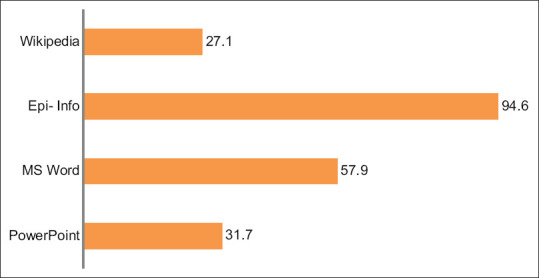
Knowledge of research analysis tools
Figure 2.
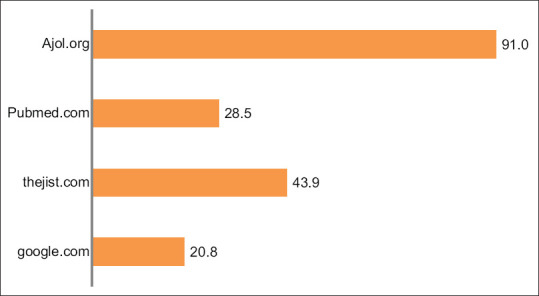
Knowledge of research biomedical search engines
Figure 3.
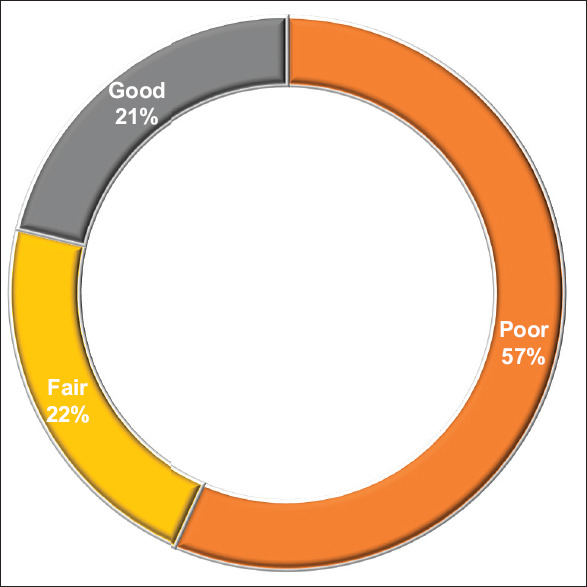
Overall knowledge of respondents about medical research
Factors affecting knowledge
Knowledge was significantly positively correlated with the level of the study; the higher levels of study had higher knowledge scores (χ2 = 74.4, P < 0.0001). There was also a significant positive correlation with prior involvement in medical research; those who had been involved in previous research had higher knowledge scores (χ2 = 6.29, P = 0.01).
With regard to attitudes, more respondents agreed that research had to have monetary and financial benefits (130, 58.8%); however, in less than half of the respondents, there was general agreement that research experience should be a criterion for residency application, thereby ensuring its relevance (107, 48.4%), and that medical research should be included into the medical curriculum from 200 level (100, 45.2%). There were poor levels of agreement with the notions that undergraduate students should participate in research (17, 7.7%) or that the role of research in the medical field is important (7, 3.2%) [Table 3]. Overall, there was good attitude toward research with 175 (79.2%) giving 10 or more positive responses [Figure 4].
Figure 4.
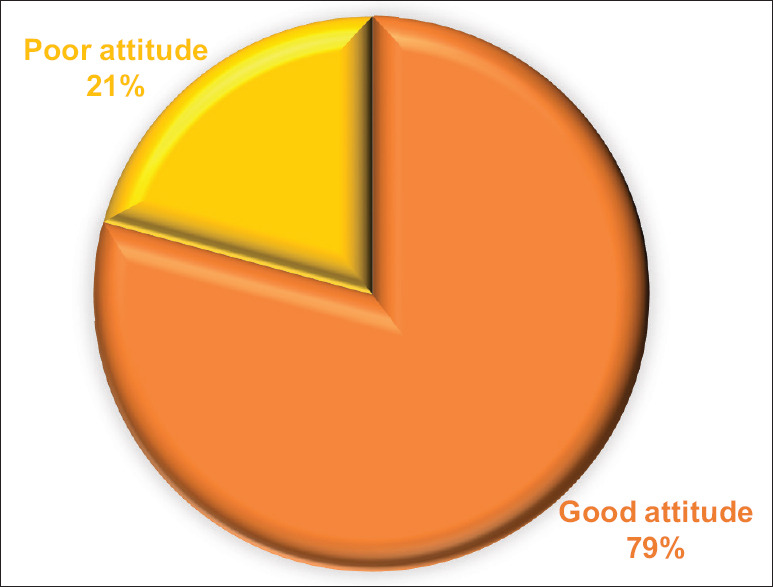
Overall attitude of respondents
Willingness and barriers to research
Willingness was examined by the responses to 6 items. The most often reported item of willingness was “not knowing how to get involved,” to which 195 (88.2%) of respondents indicated agreement. Other factors affecting willingness noted by the respondents include; The medical curriculum is too demanding” (184, 83.3%), “Unsure of opportunities available” (151, 68.3%), “Research is stressful and complex” (147, 66.5%), “Would rather focus on specialties that improve job opportunities” (120, 54.3%) and “I don't even know what research entails” (75, 33.9%) [Figure 5]. There was a significant negative association between the willingness to do research and prior involvement with voluntary or curriculum-required research (χ2 = 19.3, P = 0.04). Respondents that had prior involvement in research were less willing to do research. There was also a negative association between willingness and level of study; those in the lower levels were more willing to do research than those in the higher levels who had more likely been involved in research (χ2 = 32.6, P = 0.04). There was a statistically significant association between previous secondary education and willingness for research (χ2 = 25.2, P = 0.03).
Figure 5.
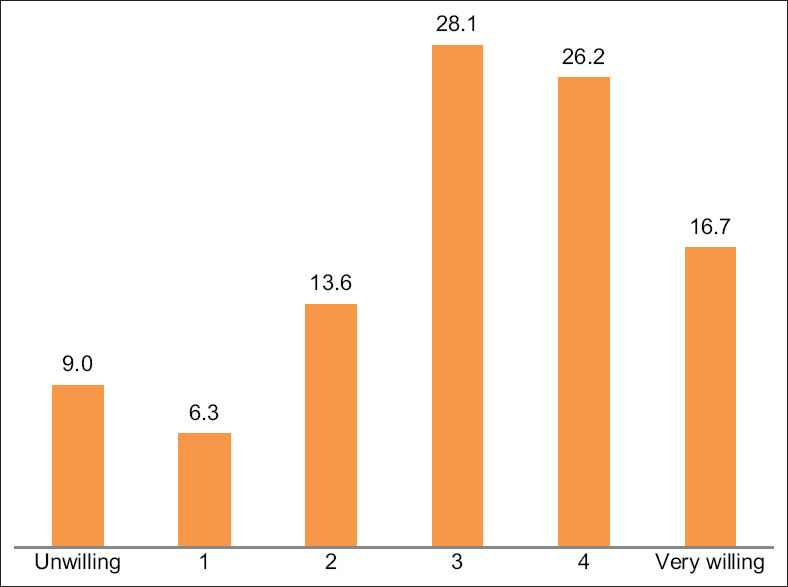
Willingness to do research
Barriers were thematically described as being either personal or systemic. Personal barriers reported were “lack of reward or motivation for research” (155, 70.1%), “difficulty in obtaining approval for study” (111, 50.2%), and “lack of personal interest in research” (81, 36.7%). Of these barriers, there was a significant positive association with personal interest. Those who indicated prior involvement with research also indicated that they had a personal interest (χ2 = 7.3, P = 0.03).
Systemic barriers reported were “lack of funding for research” (176, 79.6%), “lack of research and biostatistics curriculum” (168, 76.0%), “inadequate training in research methodology” (165, 74.7%), “insufficient time allocation to undergraduate research” (163, 73.3%), “lack of professional supervisors and proper mentoring” (130, 58.8%), and “lack of equipped laboratory facilities to conduct research” (172, 77.8%). A research methodology workshop had been planned to hold after the survey and 159 (71.9%) of respondents indicated their willingness to participate [Figure 6].
Figure 6.
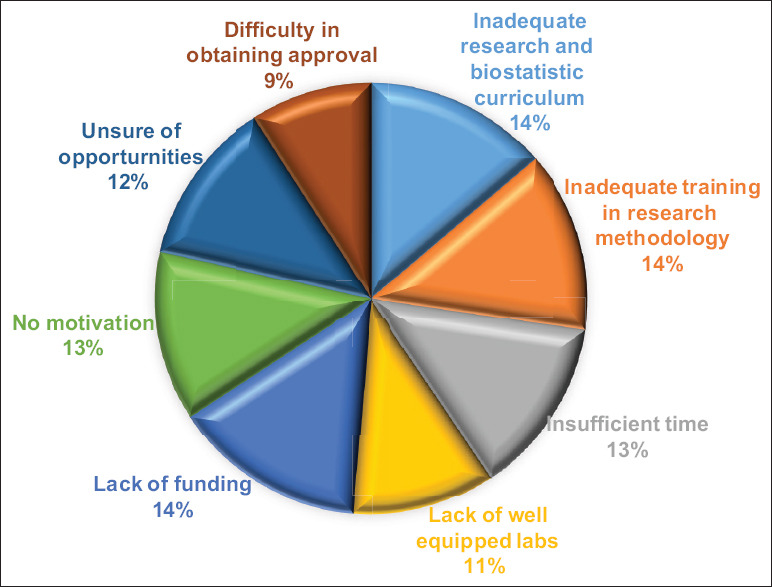
Barriers to participation in research
DISCUSSION
To our knowledge, this is the first attempt to study the attitudes and perceived barriers to research among medical students carried out by medical students in Nigeria. The use of the students themselves as research assistants seems to have allowed the participants to express themselves without a fear of reprisal. The predominant proportion of private secondary school educational background is also indicative of the attitude to research. Private secondary school education has more exposure to the newer concepts of self-directed learning. The proportion of respondents that had been involved in prior research reflects the curriculum-required research that all undergraduates of the University of Lagos must undertake. The low proportions of presentations and publications confirms the challenges of research undertaken in LMICs with little or no sponsorships or funding and inadequate training of the researchers and research supervisors.21,22,23 The contributions of medical student research to the body of knowledge have been documented to be a useful indicator of the prestige of a medical school.24,25
Knowledge about research, what it entails, analytical tools and biomedical search engines were generally poor among respondents. Knowledge scores were poorer at lower levels of study and in respondents who had no prior involvement in research. However, the lower levels of study are in a newer curriculum based on the student-centered, problem-based learning (PBL) model, which has been reported elsewhere to improve the skills and attitudes of medical students to health research.26,27,28 Despite the poor knowledge, there was an overall good attitude to research; however, in this study, medical students in the clinical years were significantly less likely to have a positive attitude toward research than preclinical students. This is in contrast to the findings from other research in other similar contexts which report that higher levels of study correlate positively with better attitudes to research, the assumption being that an increased awareness and maturity among students in their clinical years leads to a better outlook. In this study, there was a steady decline first in the response rate to the survey and decidedly in the willingness to be involved in research25,29,30 This was not examined thoroughly, but the finding that among the barriers to research, respondents had reported the lack of supervision and mentoring leads to the assumption that there are gaps in faculty capacity to instill a research-oriented mindset in the students.
The influence of the PBL model of learning on engendering good attitudes to research has also been reported and this positive influence has implications for improving the research output of the university. 26 The very low number of respondents that had either presented at a local/international conference or had published compares to the experience reported in the UK where a survey of 515 students across 7 medical schools reported that 17.1% had published their research, and similarly, 17.6% of student research had been published from undergraduate research in Peruvian medical schools. 31,32
The personal barriers reported in this study related to lack of funding and difficulty in obtaining approval for the research. Both of these are well-documented barriers to first-time researchers, but the advantage of faculty and older researchers is that they have the advantages of access to research funding and experience with the administrative framework required. This underscores the need for more active mentoring and supervision, active initiation of junior colleagues and medical students to the intricacies of quality clinical research. Griffin and Hindocha had reported that 91% of study participants wanted to take part in clinical research, 62% felt they had not been encouraged by their senior colleagues, and 57% would like to be involved in research publication to gain experience.31 Even though this study did not examine these questions in this detail, the inference can still be made that this is an issue that can and should be leveraged on to improve quality and quantity of clinical research.
The other four main barriers to conducting research were inadequate time allocated to student research, inadequate training in methodology, inadequate research and biostatistics curriculum, and lack of well-equipped laboratory facilities. Similar barriers have been reported elsewhere in both developing and developed countries.1,29,33,34 In the Canadian study, 33 as in this study, there was a comparable trend toward agreement that research experience should be a criterion for residency application. This is revealing of the opportunities that we have in encouraging better quality undergraduate research as a means to improving the residency experience and output.
The Japanese study reported the barriers faced by physicians getting involved in research and noted that “paperwork” was a problem, despite the fewer regulatory obstacles in the country to carry out clinical research. Sumi et al. suggested that there is benefit in setting up clinical research support in the form of an administrative center.35 The importance of having a structure in place to assist with the administration of clinical research is an idea that has been documented previously as part of a strategy to improve the output of clinical research.36 The study site, CMUL, has an established research administrative center, but perhaps the awareness of its roles and responsibilities needs to be communicated to the undergraduates as part of enhancing the mentored supervision. As was documented over 25 years ago, the factors that lead to improved interest in clinical and academic medical research have not changed much. It is important that an effective targeted leadership through mentored supervision is critical to creating a research-oriented mindset in medical students.37
This study has some limitations that need to be taken into cognizance in the interpretation and generalizability of the results. The results are derived from self-reporting on the knowledge, attitudes, and perceived barriers to conducting research as medical students and no independent verification of data was carried out. Students who chose not to fill the questionnaire were not examined to determine whether there was any fundamental difference between them and those who participated in the survey. There is a possibility of self-selection bias in that those who filled the questionnaires are friends of the research assistants utilized. Since a majority of student did not participate in the study, it is difficult to generalize the findings to the general population; therefore, there is a need for a more comprehensive study. The low response rate was unexpected and could be reflective of student attendance at lectures and seminars or general lack of interest in things pertaining to research.
CONCLUSION
Undergraduate medical students had overall poor knowledge of the definition of and tools needed to carry out clinical research. There was also poor research output in the form of conference presentations and publications. Our results highlight the need for more mentored supervision and training to improve their knowledge of the principles and techniques of clinical research and increase their involvement. The establishment's research administrative center can be used to assist in the production of study documents and guide the dissemination of results by presentation and publication.
Financial support and sponsorship
Nil.
Conflicts of interest
There are no conflicts of interest.
Acknowledgments
We express appreciation to all the medical students who participated in the survey, the Head of Department of Community Health and Primary Care, Dean of the Faculty of Clinical Sciences, the Provost, College of Medicine, University of Lagos. And the members of the AMSUL executive board 2016/2017 session for their assistance.
REFERENCES
- 1.Burgoyne LN, O'Flynn S, Boylan GB. Undergraduate medical research: the student perspective. Medical Edu Online. 2010;15:5212. doi: 10.3402/meo.v15i0.5212. [DOI] [PMC free article] [PubMed] [Google Scholar]
- 2.Barbosa JM, Magalhães SI, Ferreira MA. Call to publish in an undergraduate medical course: Dissemination of the final-year research project. Teach Learn Med. 2016;28:432–8. doi: 10.1080/10401334.2016.1182916. [DOI] [PubMed] [Google Scholar]
- 3.Coller BS. Translating from the rivers of Babylon to the coronary bloodstream. J Clin Invest. 2012;122:4293–9. doi: 10.1172/JCI66867. [DOI] [PMC free article] [PubMed] [Google Scholar]
- 4.Kwan JM, Daye D, Schmidt ML, Conlon CM, Kim H, Gaonkar B, et al. Exploring intentions of physician-scientist trainees: Factors influencing MD and MD/PhD interest in research careers. BMC Med Educ. 2017;17:115. doi: 10.1186/s12909-017-0954-8. [DOI] [PMC free article] [PubMed] [Google Scholar]
- 5.Solomon SS, Tom SC, Pichert J, Wasserman D, Powers AC. Impact of medical student research in the development of physician-scientists. J Investig Med. 2003;51:149–56. doi: 10.1136/jim-51-03-17. [DOI] [PubMed] [Google Scholar]
- 6.Phillipson EA. Is it the clinician-scientist or clinical research that is the endangered species? Clin Invest Med. 2002;25:23–5. [PubMed] [Google Scholar]
- 7.Thompson JN, Moskowitz J. Preventing the extinction of the clinical research ecosystem. JAMA. 1997;278:241–5. [PubMed] [Google Scholar]
- 8.Schechter AN. The crisis in clinical research: Endangering the half-century National Institutes of Health Consensus. JAMA. 1998;280:1440–2. doi: 10.1001/jama.280.16.1440. [DOI] [PubMed] [Google Scholar]
- 9.Rosenberg LE. Medicine-physician-scientists-endangered and essential. Science. 1999;283:331–2. doi: 10.1126/science.283.5400.331. [DOI] [PubMed] [Google Scholar]
- 10.Dickler HB, Fang D, Heinig SJ, Johnson E, Korn D. New physician-investigators receiving National Institutes of Health research project grants: A historical perspective on the “endangered species”. JAMA. 2007;297:2496–501. doi: 10.1001/jama.297.22.2496. [DOI] [PubMed] [Google Scholar]
- 11.Gordon R. The vanishing physician scientist: A critical review and analysis. Account Res. 2012;19:89–113. doi: 10.1080/08989621.2012.660076. [DOI] [PubMed] [Google Scholar]
- 12.Lloyd T, Phillips BR, Aber RC. Factors that influence doctors' participation in clinical research. Med Educ. 2004;38:848–51. doi: 10.1111/j.1365-2929.2004.01895.x. [DOI] [PubMed] [Google Scholar]
- 13.Funston G, Piper RJ, Connell C, Foden P, Young AM, O'Neill P. Medical student perceptions of research and research-orientated careers: An international questionnaire study. Med Teach. 2016;38:1041–8. doi: 10.3109/0142159X.2016.1150981. [DOI] [PubMed] [Google Scholar]
- 14.Murdoch-Eaton D, Drewery S, Elton S, Emmerson C, Marshall M, Smith JA, et al. What do medical students understand by research and research skills? Identifying research opportunities within undergraduate projects. Med Teach. 2010;32:e152–60. doi: 10.3109/01421591003657493. [DOI] [PubMed] [Google Scholar]
- 15.Whitworth JA, Kokwaro G, Kinyanjui S, Snewin VA, Tanner M, Walport M, et al. Strengthening capacity for health research in Africa. Lancet. 2008;372:1590–3. doi: 10.1016/S0140-6736(08)61660-8. [DOI] [PMC free article] [PubMed] [Google Scholar]
- 16.Sabzwari S, Kauser S, Khuwaja AK. Experiences, attitudes and barriers towards research amongst junior faculty of Pakistani medical universities. BMC Med Educ. 2009;9:68. doi: 10.1186/1472-6920-9-68. [DOI] [PMC free article] [PubMed] [Google Scholar]
- 17.Sadana R, D'Souza C, Hyder AA, Chowdhury AM. Importance of health research in South Asia. BMJ. 2004;328:826–30. doi: 10.1136/bmj.328.7443.826. [DOI] [PMC free article] [PubMed] [Google Scholar]
- 18.Hennink M, Stephenson R. Using research to inform health policy: Barriers and strategies in developing countries. J Health Commun. 2005;10:163–80. doi: 10.1080/10810730590915128. [DOI] [PubMed] [Google Scholar]
- 19.Aslam F, Shakir M, Qayyum MA. Why medical students are crucial to the future of research in South Asia. PLoS Med. 2005;2:e322. doi: 10.1371/journal.pmed.0020322. [DOI] [PMC free article] [PubMed] [Google Scholar]
- 20.College of Medicine. [Last accessed on 2018 Jul 25]. Available from: http://cmul.unilag.edu.ng/
- 21.Sabzwari S, Kauser S, Khuwaja AK. Experiences, attitudes and barriers towards research amongst junior faculty of Pakistani medical universities. BMC Med Educ. 2009;9:68. doi: 10.1186/1472-6920-9-68. [DOI] [PMC free article] [PubMed] [Google Scholar]
- 22.Fatima M, Zehra N, Ahmad F, Obaid MS. Awareness regarding research skills among clinical and academic post graduate doctors in teaching hospitals of Karachi. J Pak Med Assoc. 2014;64:624–8. [PubMed] [Google Scholar]
- 23.Khan H, Khan S, Iqbal A. Knowledge, attitudes and practices around health research: The perspective of physicians-in-training in Pakistan. BMC Med Educ. 2009;9:46. doi: 10.1186/1472-6920-9-46. [DOI] [PMC free article] [PubMed] [Google Scholar]
- 24.Aslam F, Waheed A. An audit of the students' corner of Journal of the Pakistan Medical Association. J Pak Med Assoc. 2005;55:517–9. [PubMed] [Google Scholar]
- 25.Khan H, Khawaja MR, Waheed A, Rauf MA, Fatmi Z. Knowledge and attitudes about health research amongst a group of Pakistani medical students. BMC Med Educ. 2006;6:54. doi: 10.1186/1472-6920-6-54. [DOI] [PMC free article] [PubMed] [Google Scholar]
- 26.Khan H, Taqui AM, Khawaja MR, Fatmi Z. Problem-based versus conventional curricula: Influence on knowledge and attitudes of medical students towards health research. PLoS One. 2007;2:e632. doi: 10.1371/journal.pone.0000632. [DOI] [PMC free article] [PubMed] [Google Scholar]
- 27.Pruskil S, Burgwinkel P, Georg W, Keil T, Kiessling C. Medical students' attitudes towards science and involvement in research activities: A comparative study with students from a reformed and a traditional curriculum. Med Teach. 2009;31:e254–9. doi: 10.1080/01421590802637925. [DOI] [PubMed] [Google Scholar]
- 28.Nel D, Burman RJ, Hoffman R, Randera-Rees S. The attitudes of medical students to research. S Afr Med J. 2013;104:33–6. doi: 10.7196/samj.7058. [DOI] [PubMed] [Google Scholar]
- 29.Al-Hilali SM, Al-Kahtani E, Zaman B, Khandekar R, Al-Shahri A, Edward DP. Attitudes of Saudi Arabian undergraduate medical students towards health research. Sultan Qaboos Univ Med J. 2016;16:e68–73. doi: 10.18295/squmj.2016.16.01.012. [DOI] [PMC free article] [PubMed] [Google Scholar]
- 30.Noorelahi MM, Soubhanneyaz AA, Kasim KA. Perceptions, barriers, and practices of medical research among students at Taibah College of Medicine, Madinah, Saudi Arabia. Adv Med Educ Pract. 2015;6:479–85. doi: 10.2147/AMEP.S83978. [DOI] [PMC free article] [PubMed] [Google Scholar]
- 31.Griffin MF, Hindocha S. Publication practices of medical students at British medical schools: Experience, attitudes and barriers to publish. Med Teach. 2011;33:e1–8. doi: 10.3109/0142159X.2011.530320. [DOI] [PubMed] [Google Scholar]
- 32.Arriola-Quiroz I, Curioso WH, Cruz-Encarnacion M, Gayoso O. Characteristics and publication patterns of theses from a Peruvian medical school. Health Info Libr J. 2010;27:148–54. doi: 10.1111/j.1471-1842.2010.00878.x. [DOI] [PubMed] [Google Scholar]
- 33.Siemens DR, Punnen S, Wong J, Kanji N. A survey on the attitudes towards research in medical school. BMC Med Educ. 2010;10:4. doi: 10.1186/1472-6920-10-4. [DOI] [PMC free article] [PubMed] [Google Scholar]
- 34.Giri PA, Bangal VB, Phalke DB. Knowledge, Attitude and Practices towards Medical Research amongst the Postgraduate Students of Pravara Institute of Medical Sciences University of Central India. J Family Med Prim Care. 2014;3:22–4. doi: 10.4103/2249-4863.130263. [DOI] [PMC free article] [PubMed] [Google Scholar]
- 35.Sumi E, Murayama T, Yokode M. A survey of attitudes toward clinical research among physicians at Kyoto University Hospital. BMC Med Educ. 2009;9:75. doi: 10.1186/1472-6920-9-75. [DOI] [PMC free article] [PubMed] [Google Scholar]
- 36.McCurry J. Japan unveils 5-year plan to boost clinical research. Lancet. 2007;369:1333–6. doi: 10.1016/S0140-6736(07)60615-1. [DOI] [PubMed] [Google Scholar]
- 37.Goldhamer ME, Cohen AP, Bates DW, Cook EF, Davis RB, Singer DE, et al. Protecting an endangered species: Training physicians to conduct clinical research. Acad Med. 2009;84:439–45. doi: 10.1097/ACM.0b013e31819a7cb1. [DOI] [PubMed] [Google Scholar]


